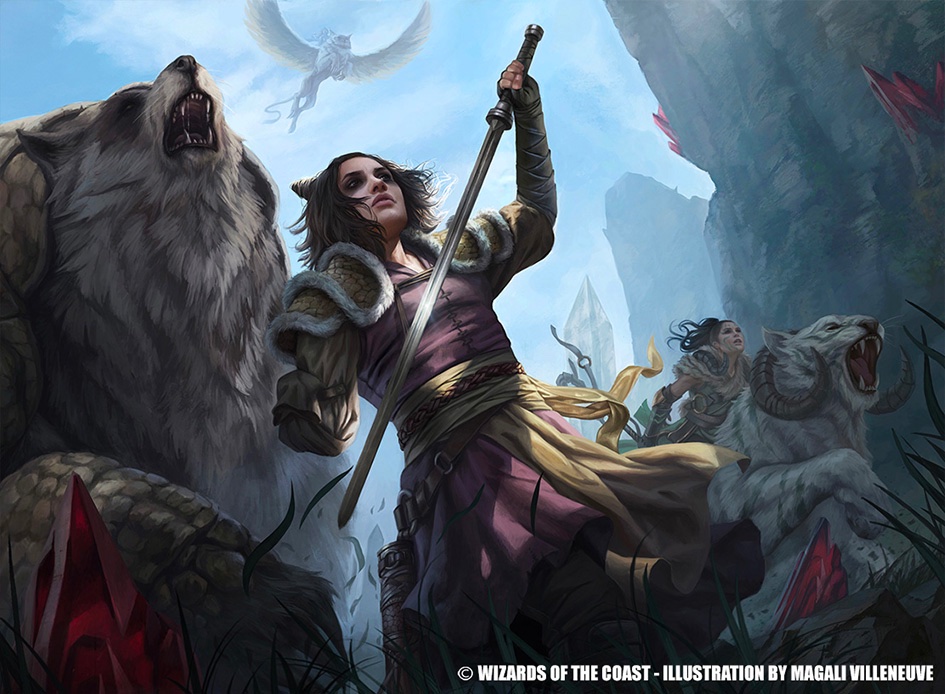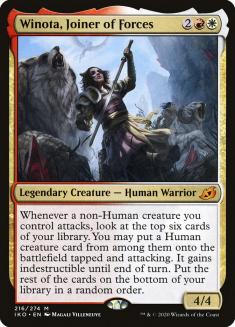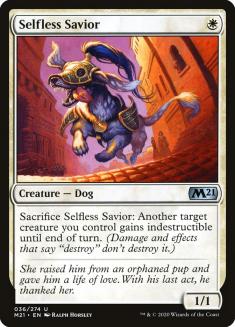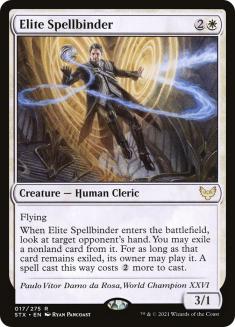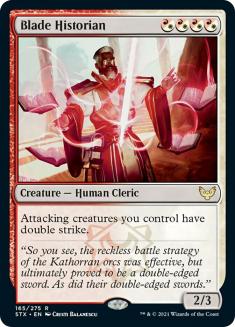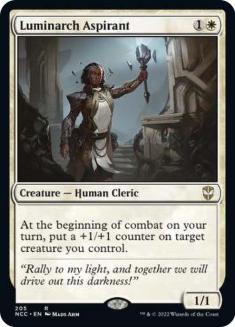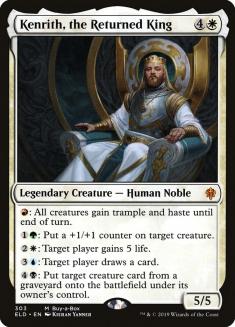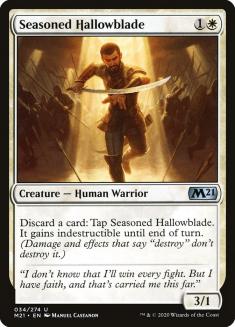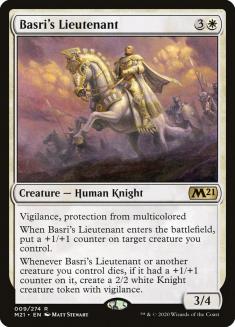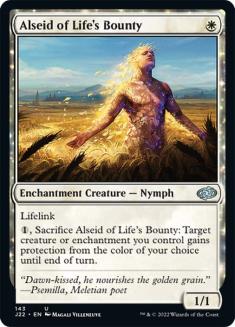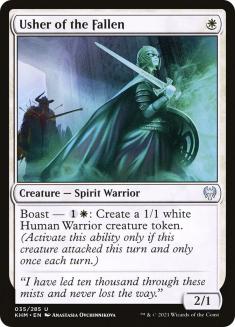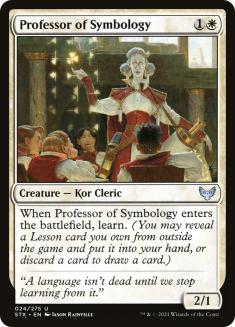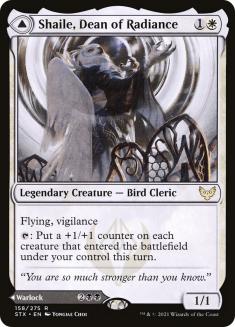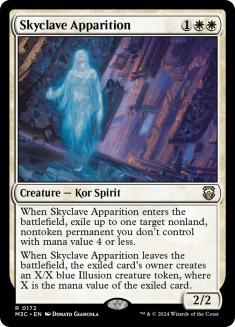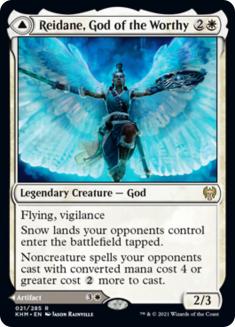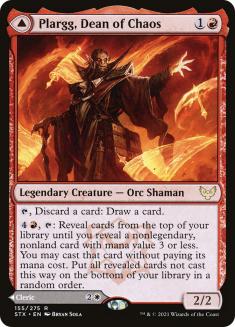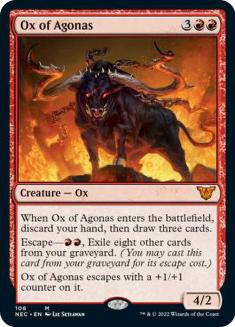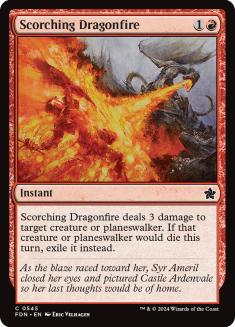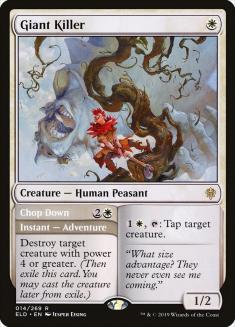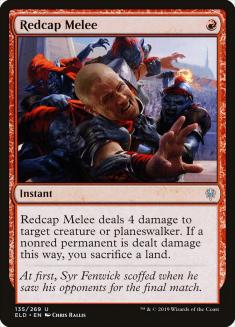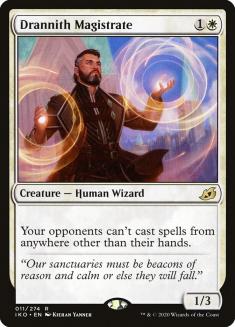A while ago, I wrote about Winota, Joiner of Forces decks in Strixhaven Standard. I’ve since played a lot with them (and against them — the deck is quite popular on ladder) and I’ve refined my list to a point where I’m pretty happy with it and think it can put up a real fight with most of the top decks in Standard. Let’s start talking about the decklist.
The first order of business is to just play straight Boros, because you have a much better fair game. Decks like Mardu and Naya have more explosive Winota games, but Boros wins most of the Winota games anyway, so it’s better to focus on making sure you have a good shot in the fair games, and that’s most definitely Boros due to having better mana and a better plan (the tricolor versions have a very hard time casting Blade Historian, for example, plus more lands that will enter the battlefield tapped).
As for the list itself:
The Must-Haves
The list of “must-haves” in a Winota, Joiner of Forces deck is quite small. Obviously Winota herself is a must-have. Past that I think the two best enablers are Selfless Savior and Bonecrusher Giant, and the two best payoffs are Elite Spellbinder and Blade Historian.
Selfless Savior is just an all-star at both triggering and protecting Winota, and Bonecrusher Giant offers you some removal spells in a creature-heavy deck and is one of the best cards in your fair wins. I would play more of each of them if I could.
Elite Spellbinder and Blade Historian are both the best hits off Winota and the best hits in a fair game. Drawing something like Kenrith, the Returned King is an embarrassment most of the time, whereas Blade Historian can be somewhat comparable to Torbran, Thane of Red Fell, and Elite Spellbinder is just a great card in an aggressive deck (I know, I know).
The Humans
Blade Historian and Elite Spellbinder are the best, but they’re not enough. With these eight cards, you’re 60% to hit on a Winota trigger. If we consider that Winota herself is a hit (you don’t add any material to your battlefield but you effectively give it haste), then it moves up to 72%. Considering that hitting multiple Winotas does not accomplish anything, I would like to have more hits, as missing over a fourth of the time I trigger Winota does not sit very well with me. So, what are our options?
Luminarch Aspirant is an incredible card in a fair game, but it basically doesn’t count as a Winota hit. Even if you have Blade Historian, it can easily be blocked on the Winota turn and, if not, it attacks for one or two. I would not consider it in my calculations.
As mentioned before, I think Kenrith is too much of an embarrassment to draw and I’m looking for cards that facilitate both styles of play the deck has.
Seasoned Hallowblade is a good balance of fair card and a reasonable hit. Is it a good hit? No, but three is a lot more than one, especially with double strike. Whenever I hit Luminarch Aspirant I felt like I hit nothing, and whenever I hit Seasoned Hallowblade I think it usually counts as a hit. For this reason, I’ve liked playing this card. It also has some interesting applications with Ox of Agonas in sideboarded games, especially versus Dimir Rogues.
Basri’s Lieutenant is the best of the “big hits,” as it’s pretty powerful but also castable (and works quite well with Shaile, Dean of Radiance). However, the deck already has eight four-drops, and I don’t think you need the extra hit, so I’ve been happy without it.
So, in the end, we have four copies each of:
- Elite Spellbinder
- Blade Historian
- Seasoned Hallowblade
- Winota, Joiner of Forces
This gives us 75% to hit a non-Winota Human and 93% to hit a Human counting Winota. It’s not the best possible, and I would like to hit more often, but I think it’s good enough to work with. If there were another great Human to play I would be playing it, but I simply don’t think there is.
The Enablers
There are plenty of good non-Humans to play, but the main deterrent is the mana cost. Ideally, you’d rather all your expensive (three-plus-mana) creatures be Humans, and all your cheap creatures be non-Humans; however, we’re a bit constrained in this regard, which means we end up with a lot of expensive non-Humans and cards like Seasoned Hallowblade. If we could swap the costs of those it would be ideal, but the cards aren’t there for it (yet), and we need to work with what we’ve got.
Alseid of Life’s Bounty is a reasonable card — it resembles Selfless Savior in a lot of ways. However, this deck rarely has open mana and it even more rarely has open mana in the Winota turns, so protecting a creature with it is much harder. You don’t have any pump effects to make good use of the lifelink like the Mono-White Aggro❄ deck does, so you’re mostly using it for the second ability and it’s not that great. If you maindeck Lurrus of the Dream-Den then this is a possibility, but I currently don’t have Lurrus in my deck so I also don’t have Alseid.
Usher is my choice for one-drop. Unfortunately it makes Human tokens, otherwise it’d be a slam dunk, but I think it’s still good enough to play. A 2/1 is just a much better card than a 1/1 (especially if you’re attacking and hoping to hit the double-striker — the Alseid will just be blocked and die a lot of the time, whereas Usher will trade if you hit) and the token it makes can be helpful when you’re flooded or playing around sweepers.
Professor of Symbology was supposed to be the Chosen One, but in reality I didn’t like it very much. The Lessons are just too weak and a 2/1 body for two mana is not very good in fair games. It’s close to being good in this deck, and it’s possible that I’m wrong about it, but my current version includes zero copies. It really surprises me that people are playing this in Mono-White Aggro❄. It’s certainly much better in Winota than it is in Mono-White❄ and I still don’t think it’s good enough here. It’s a pretty good card when you mulligan, though, since it fills your curve entirely by itself. If the next card on the list didn’t exist, I might be playing Professor of Symbology still.
Shaile has grown on me since I started playing her. 1/1 is obviously unimpressive, but she can attack freely without issues most of the time, since she has flying, and the ability ends up adding a lot of potential more damage. For example, if you cast Shaile on Turn 2, then another creature on Turn 3 (and pump it) and then hit two creatures from Winota, that’s an extra three power that Shaile has given you.
Most importantly, it’s very helpful for protecting Winota and Blade Historian from Heartless Act. If you have Shaile up, you can just cast Winota and go to combat and they’re powerless to stop it (if they try to Heartless Act, you just activate Shaile and the +1/+1 counter will fizzle the spell). This means they have to Heartless Act Shaile itself, which in turn means it acts as an extra copy of Selfless Savior against that card specifically.
Most Winota lists I’ve seen have four Skyclave Apparitions. Personally, I haven’t found it to be that good. In theory, it makes sense — you remove a creature while adding a Winota enabler. The problem is that for it to be a Winota enabler it has to attack, often into bigger creatures, and sometimes it just dies in combat. A three- or four-power creature will usually trade with a blocker even if you miss, but Skyclave Apparition will often just throw itself in the graveyard.
It’s still a good card, though, and I’m playing three copies with another one in the sideboard. I just don’t think it’s a must-play-four.
Reidane was a card I had in my sideboard for the longest time, but it was so good for me that I moved one copy to the maindeck. The key here is that it’s not only an attacker for Winota but also quite a good one (the opposite of Skyclave Apparition). It’s excellent versus the expensive control decks and also excellent versus Mono-Red Aggro❄ (where both sides are quite good), so it has enough applications that I think it can be maindeckable.
Venerable Warsinger is a pretty good combo with Selfless Savior and Alseid, and I didn’t hate it when I played it originally, but it didn’t do a great job of connecting and most of the time it did connect there was nothing in the graveyard (though it can sometimes combo with Seasoned Hallowblade). I thought it was an acceptable card, but not good enough to include.
I’ve also found Lurrus to be not good enough. Your important cards usually cost three or more mana anyway, and it’s sort of a package deal with Alseid which I don’t want to play.
Plargg, Dean of Chaos is my latest experiment. As a 2/2 for two mana, it’s vulnerable to Bonecrusher Giant (same as Shaile), but if they don’t kill it it’s actually been pretty reasonable for me. The deck has a weird mix of cards you want at various stages of the game, so Plargg helps filtering out to make sure you find your cards in the right moments, and the second ability is better than just drawing a card, so it can get quite threatening on stalled battlefields. Besides, unlike Shaile you can actually play the back side of it, though that’s not very common.
So, where does that leave us?
Playing the Deck
The most important thing to understand when it comes to Boros Winota is that this deck has two very distinct styles of play — Winota games and fair games. Winota games are the ones you just curve creatures into a Winota and then you win the game by default — they can happen against anyone and are not easy to stop. Fair games are the ones in which this does not happen — in which you have to block, trade creatures, and use removal spells.
Understanding which style of game you’re playing is important because it informs how you behave during the game. If you’re playing a Winota game, then Winota is capable of winning the game by itself, and whatever else you have done earlier in the game does not matter as long as you’re setting up for it and have creatures on the battlefield ready to attack (whether you or they are at ten or twenty life is mostly irrelevant, for example). You might also skip on casting Stomp just to curve out with another creature that triggers Winota.
If you’re playing a fair game, you have to be much more careful about what is happening. You need to watch your life total, you need to trade creatures, you need to cast some removal spells, and get two-for-ones from your Bonecrusher Giants.
For example, one common situation I find myself in is whether I offer a trade with my Selfless Savior or not. Imagine your opponent has Edgewell Innkeeper — do you want this trade? Most of the time, the answer is yes because their card is better. If you have Winota in your hand, then most of the time the answer is no, because this Selfless Savior is not only a Selfless Savior, it’s a Selfless Savior and a Winota trigger.
The same is true for Bonecrusher Giant and Stomp. Imagine that your hand contains a non-Human two-drop (say Shaile, Dean of Radiance) and Bonecrusher Giant. Your opponent has a creature that you can kill on the battlefield (such as the aforementioned Edgewell Innkeeper). Normally, you’d just Stomp the Innkeeper. If you have Winota in your hand, you might consider casting the Shaile instead and then just casting the Bonecrusher Giant Turn 3, since the extra trigger is worth more than killing their creature.
Of course, sometimes you’re not going to know exactly which way the game is going to play out, but most of the time to have a Winota game you need several creatures that trigger Winota and then Winota herself. Sometimes you have Winota but no enablers, so it’s not really going to be a Winota game and you need to play accordingly. Sometimes you think it’s going to be a Winota game and then you never draw a fourth land and it ends up turning into a fair game midway (this is unfortunate but can definitely happen, the best you can do is often a guess).
Past that, the deck is not very hard to play. Both the fair and the unfair plans are relatively straightforward to execute if you know which one you have to go for.
Matchups
VS Dimir Rogues (Lurrus)
Dimir Rogues is a notoriously hard matchup for Mono-White Aggro❄, and a notoriously easy one for Mono-Red Aggro❄. So, does this mean Boros is in the middle? Actually, I think you’re favored versus Dimir Rogues, as you have most of the elements that make Mono-Red❄ good in that matchup (but not all — Mono-Red❄ is still a better deck versus Dimir Rogues). Game 1 is tough, but having a single removal spell in the form of Bonecrusher Giant goes a long way, as it makes attacking easier and it gives you another way to remove Lurrus which is otherwise one of the most problematic cards.
Out:
In:
After sideboarding, your deck becomes less focused on Winota. You take out a lot of the enablers and some of the hits, but this is fine because it’s very rare you can play the Winota game. The sideboarded games are favorable, because you now have enough removal to just ride Ox of Agonas to victory.
VS Sultai Ramp (Yorion)
This matchup ranges from even to slightly unfavorable, depending on their list. Their good draws are very hard to beat, but their bad draws will usually lose. The biggest problem in Game 1 is actually Elder Gargaroth — you have no answer to it and you have to attack into it to hope to accomplish anything. If they have multiples of that card, it becomes much tougher to win, and you should time your Elite Spellbinders so that you can exile it. The saving grace is that you’re better than normal against sweepers. Your four-mana creatures dodge Shadows’ Verdict and you’re pretty evenly split between odd and even costs for Extinction Event.
Out:
In:
After sideboarding, it usually becomes a bit tougher for you as they have more removal spells (but overall it shouldn’t change very much). If you know they have a lot of creatures, you can bring in the third Giant Killer as well.
VS Mono-Red Aggro❄
I think this matchup is good. Both your plans work well versus them and Winota is kinda comparable to Embercleave, but the surrounding pieces here are better. Seasoned Hallowblade is actually one of your best cards as it makes attacking into you very hard, and Elite Spellbinder and Reidane can delay and sometimes completely stop their Embercleave.
Out:
In:
After sideboarding both players usually bring in a lot of removal spells, so the game slows down a bit more and Seasoned Hallowblade shines even more. You cut down a lot of Winota enablers, but that’s mostly fine since you don’t need big Winota turns to win.
VS Naya Tokens
This is a bad matchup. Your fair plan never works against them because they’re much better at it than you are, and they have the tools to keep you off the busted Winota draws. Still, your best way to win is to just goldfish them with Winota, which does happen some of the time. It’s not easy to keep three mana up for Chop Down every turn of the game.
Out:
In:
After sideboarding things improve a bit. Drannith Magistrate is quite good versus them and Scorching Dragonfire makes it easier to deal with Clarion Sprit and Edgewell Innkeeper.
VS Mono-White Aggro❄
This is a good matchup. Your decks are similar, except Winota trumps anything they can do (for the most part) and you have more removal spells. They have Chop Down for Winota, but keeping three mana up every turn is pretty taxing, so if you don’t have Selfless Savior consider if you can just cast something else and not run into it.
Out:
In:
After sideboarding things get even better, as they don’t have any more Winota removal spells and you bring in a good amount of stuff.
All in all, I don’t think Boros Winota is necessarily the best deck in Strixhaven Standard, but I do think it’s the best aggro deck in Strixhaven Standard. I’ve found it to be better than both Mono-Red Aggro❄ and Mono-White Aggro❄, and if you like this play style, you should give it a try.

